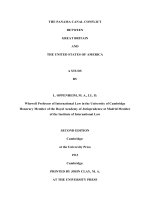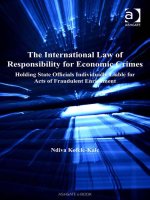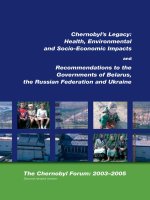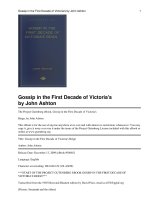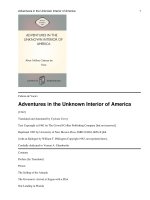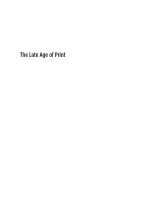“Mostly Free” The Startling Decline of America’s Economic Freedom and What to Do About It pdf
Bạn đang xem bản rút gọn của tài liệu. Xem và tải ngay bản đầy đủ của tài liệu tại đây (967.96 KB, 20 trang )
SR-79
June XX, 2010
Heritage
Special Report
Published by The Heritage Foundation
By Terry Miller and
Kim R. Holmes
Center for International Trade and Economics
“
Mostly Free
”
The Startling Decline of America’s Economic
Freedom and What to Do About It
“Mostly Free”
The Startling Decline
of America’s Economic Freedom
and What to Do About It
By Terry Miller and Kim R. Holmes
An Economic Freedom
Agenda for America
Inspired by the 2010 Index of Economic Freedom
About The Heritage Foundation
The Heritage Foundation is committed to building an America
where freedom, opportunity, prosperity, and civil society flourish.
Founded in 1973, The Heritage Foundation is a research and educational institution—a think tank—whose
mission is to formulate and promote conservative public policies based on the principles of free enterprise,
limited government, individual freedom, traditional American values, and a strong national defense.
We believe the principles and ideas of the American Founding are worth conserving and renewing. As policy
entrepreneurs, we believe the most effective solutions are consistent with those ideas and principles. Our vision
is to build an America where freedom, opportunity, prosperity, and civil society flourish.
Heritage’s staff pursues this mission by performing timely, accurate research on key policy issues and
effectively marketing these findings to our primary audiences: members of Congress, key congressional
staff members, policymakers in the executive branch, the nation’s news media, and the academic and policy
communities.
Governed by an independent Board of Trustees, The Heritage Foundation is an independent, tax-exempt
institution. Heritage relies on the private financial support of the general public—individuals, foundations,
and corporations—for its income, and accepts no government funds and performs no contract work. Heritage
is one of the nation’s largest public policy research organizations. More than 671,000 individual members make
it the most broadly supported think tank in America.
The 2010 Index of Economic Freedom is available at heritage.org/index.
“Mostly Free”
The Startling Decline of America’s
Economic Freedom and
What to Do About It
Terry Miller and Kim R. Holmes
The Heritage Foundation
1
“Mostly Free” — Not Good Enough!
I
n 2010, for the first time ever, the United States has fallen from the ranks of the economically “free” as
measured by the Index of Economic Freedom, published annually by The Heritage Foundation and The Wall
Street Journal. With a score of only 78.0 on the Index’s 0–100 scale, the United States has fallen below the cutoff
(an average score of 80 or above) that earns countries the right to call themselves truly “free.” The United States’
current status? “Mostly free.”
How did this happen? What can be done to address the problem and allow Americans to reclaim the
economic freedoms they have lost?
This booklet provides a snapshot of American’s economic freedom and compares conditions in the United
States with those in other countries around the world. A program of straightforward but bold reforms is pro-
posed to put the U.S. back where it belongs: as a world leader in economic freedom.
A Startling Decline
The United States is the 8th freest economy in the 2010 Index of Economic Freedom. Its score is 2.7 points
lower than last year, reflecting notable decreases in financial freedom, monetary freedom, and property rights.
Economic freedom has declined in seven of the 10 categories measured in the Index. Overall, the U.S. suffered
the largest decline in economic freedom among the world’s 20 largest economies. The United States has fallen
to 2nd place in the North America region, trailing Canada.
The U.S. government’s intrusive responses to the financial and economic crisis that began in 2008 have
significantly undermined economic freedom and long-term prospects for economic growth. Uncertainties
caused by ongoing regulatory changes and politically influenced spending have discouraged entrepreneurship
and job creation, slowing recovery. Leadership in free trade has been undercut by “Buy American” provisions
in stimulus legislation and failure to pursue previously agreed free trade agreements (FTAs) with Panama,
Colombia, and South Korea.
Meanwhile, tax rates are increasingly uncompetitive, and massive stimulus spending is creating unprec-
edented deficits. Bailouts of financial and automotive firms have generated concerns about property rights.
The health care law is adding billions of dollars to the nation’s medical bill, as well as federal and state deficits,
while fundamentally altering the structure of employment compensation.
13
37
138
122
29
18
17
22
18
3
No. 1 (Highest)
No. 180 (Lowest)
No. 120
No. 60
U.S. Ranking in 10 Economic Freedoms
Business
Freedom
Trade
Freedom
Fiscal
Freedom
Government
Spending
Monetary
Freedom
Financial
Freedom
Property
Rights
Investment
Freedom
Freedom
from
Corruption
Labor
Freedom
2
T
he U.S. Constitution was established, in the words of its Preamble, to “secure the Blessings of Liberty to
ourselves and our Posterity.” That liberty is under assault today, and the threat, now as at the time of the
Declaration of Independence, comes from a government that has become destructive of “Life, Liberty, and the
pursuit of Happiness.”
Reclaiming their heritage of economic freedom will not be an easy task for Americans. Action is needed in
every area to challenge politically powerful special interests. Politics as usual will not suffice. Indeed, it is politics
as usual that has gotten us off track, with government encroaching daily into areas that Americans have tradi-
tionally regarded as private.
We don’t need a revolution, but we do need a restoration of the rights once considered unalienable—by the
Founders and by the generations of Americans that followed them. The time to start is now. The actions that we
need to take form the Economic Freedom Agenda for America.
The following pages provide a step-by-step guide to putting the U.S. back in the top ranks of the economi-
cally “free.” The specific recommendations are but one possible strategy to restore our economic freedom. They
illustrate clearly the scope of reform that is needed. Other proposals, if honest in actually advancing economic
freedom, could serve as well.
The important thing is to act now to arrest the decline of freedom and assert our rights as free people to set
our own course toward greater prosperity in the future.
The Economic Freedom Agenda
$10
$100
$1,000
$10,000
$100,000
10 30 50 70 90
GDP per Capita, in Constant 2000 U.S. Dollars (Logarithmic Scale)
2010 Index of Economic Freedom Score
Economic Freedom Promotes Greater Prosperity
Trend Line
Each dot represents a nation in
the Index of Economic Freedom
Correlation = 0.67
R
2
= 0.4489
3
BUSINESS FREEDOM
U.S. Score: 91.3
World Rank: 13th
T
he U.S. business freedom score of 91.3 is respectable, but 12 countries do a better job. New Zealand,
which scores 99.9 in business freedom, sets the world standard. You can start a business there in
one day. Some U.S. states can probably match that, but the U.S. average is six days.
The business freedom indicator provides only a partial measure of the overall regulatory burden
on business, which is increasing rapidly in the U.S. Over 50 agencies have a hand in federal regula-
tory policy. The Code of Federal Regulations has grown from 151,000 pages in 2000 to over 163,000
pages now.
In fiscal year 2009, close to $15 billion in new regulatory costs were imposed on Americans. This is
the biggest increase in 17 years and the second highest increase ever recorded, and 2010 is likely to be
worse, primarily because of the health care bill. New rules adopted during the Obama Administration
have ranged from mandatory energy standards for soft drink vending machines to mandatory reporting
requirements for greenhouse gas emissions to new limits on credit card terms and conditions. The overall
cost for Americans of all the regulations on the books, as estimated in a recent study for the Small
Business Administration, is some $1.1 trillion.
Four areas where the regulatory burden on businesses is expanding rapidly are:
Health care.• The bill passed in 2010 imposes comprehensive rules on health insurance providers,
medical professionals, and consumers.
Climate change.• Efforts in Congress to adopt legislation to mandate caps on CO
2
use have stalled, but
the Environmental Protection Agency (EPA) is moving ahead with regulations under what it claims
is its existing authority. In January, the EPA issued a formal finding that CO
2
endangers public health,
and the agency has implemented, planned, or proposed limits on CO
2
emissions from virtually every
type of economic and non-economic activity undertaken in society.
Financial reform.• Legislation is pending to increase regulation of the financial sector, creating a new
consumer regulatory agency and giving regulators increased authority to close down institutions.
The changes would not just hinder beneficial innovation, but actually reduce stability and possibly
lead to more bailouts.
Internet regulation.• The FCC has proposed new regulations on Internet providers, limiting how
companies such as Comcast or Verizon operate their networks. These “net neutrality” rules threaten
to slow Internet access and limit investment and innovation in the sector.
Impact on the U.S.’s
Business Freedom Score
Controlling the explosive growth
of new regulation will only prevent
future drops in the U.S. business
freedom score. Implementation of
sunset clauses, however, could lead
to a signicant gain in freedom. A
reduced regulatory burden that led
to a 50 percent improvement in the
Index’s “doing business” indicators
would:
n Add 8.2 points to the U.S. busi-
ness freedom score.
n Move the U.S. business freedom
ranking from 13th place to 2nd
place.
The Economic Freedom Agenda:
Business Freedom
To improve business freedom and forestall further erosion, U.S. policy makers
need to:
n Repeal stiing regulation of health care, the environment, nancial institutions,
and the Internet.
n Create a nonpartisan Congressional Regulation Ofce to review new regulations
and their alternatives.
n Include a “sunset” date for all existing and new regulations, ensuring periodic
review and requiring positive action for reauthorization and continuation of any
regulation.
Countries Ranking
Above the U.S. in
Business Freedom
New Zealand 99.9
Hong Kong 98.7
Singapore 98.2
Denmark 97.9
Canada 96.5
Sweden 95.5
Finland 95.0
United Kingdom 94.9
Iceland 93.0
Belgium 92.9
Ireland 92.8
South Korea 91.9
United States 91.3
4
TRADE FREEDOM
U.S. Score: 86.9
World Rank: 37th
T
hirty-six economies, including Hong Kong, Switzerland, Georgia, and Namibia, outperform the
U.S. in trade freedom. Most of these economies have eliminated tariffs almost completely, though
each distorts trade somewhat through a variety of non-tariff barriers such as labeling requirements,
licensing, and subsidies.
The U.S. weighted average tariff rate, though relatively low at 1.5 percent, is still higher than the
rates in every member of the European Union (1.3 percent). And though the U.S.’s relative ranking
in trade freedom declined as other countries continued significant liberalization, its trade freedom
score at least went up a little because of a slight shift in demand away from higher-tariff items.
Trade has been a mainstay of the U.S. economy, accounting for more than 25 percent of U.S. gross
domestic product (GDP) in 2009. The U.S. remains the world’s top exporter of goods and services
combined. More than 57 million Americans are employed by firms that engage in international trade.
The 3 percent of U.S. job losses that can be attributed to foreign trade are more than balanced by the
U.S. jobs created because of trade.
One of the best ways in which the U.S. promotes trade and economic prosperity is through free
trade agreements. The largest such agreement is NAFTA. Together, Canada and Mexico constitute
America’s largest trade partner, accounting for over 80 percent of all merchandise trade between the
U.S. and our FTA partners and 28 percent of all U.S. merchandise trade in 2009. In the first 13 years
of NAFTA, U.S. GDP grew more than 50 percent, the economy created 26 million new jobs, U.S.
manu facturing output rose 63 percent, and the unemployment rate fell 2 percentage points.
U.S. Protectionism
The U.S. maintains a number of tariff and non-tariff measures that distort trade. More dispute settle-
ment cases have been filed at the World Trade Organization (WTO) against U.S. protectionist measures
than against any other country. While not all of these cases have merit, there are several areas in which the
U.S. engages in practices that significantly distort trade. The most significant are:
Tariff quotas.• About 2 percent of U.S. tariff lines are subject to tariff quotas (a specified amount of
a good—the quota—is charged a low tariff; additional imports pay a much higher tariff).
Subsidies.• The U.S. provides significant government subsidies in the areas of agriculture and energy.
Government support accounted for 11 percent of gross farm receipts in 2006.
Anti-dumping measures.• At the end of 2007, the U.S. maintained 232 anti-dumping measures
against 39 trading partners. The average length of “temporary” anti-dumping measures is 11 years.
Impact on the U.S.’s
Trade Freedom Score
Eliminating tariffs would add 3.1
points to the U.S. trade freedom
score, and eliminating subsidies
and non-WTO-compliant trade
remedies would boost the score
another 5 points.
n Together, these reforms would
incease the U.S. trade freedom
score by a total of 8.1 points.
n The U.S. would jump from 37th
place to 1st place in the trade
freedom rankings.
The Economic Freedom Agenda:
Trade Freedom
To improve trade freedom and ensure U.S. competitiveness, U.S. policymakers
need to:
n Eliminate all remaining U.S. tariffs and import quotas. A scheduled phaseout
over a decade would allow orderly adjustment in those sectors, like sugar and
dairy, that are heavily subsidized by protectionism.
n Reform U.S. trade remedies to bring them into compliance with international
trade rules. In particular, end the practice of “zeroing” in calculating dumping
margins.
n End trade-distorting U.S. agricultural and energy subsidies, including subsidies
for ethanol.
n Implement pending free trade agreements with South Korea, Colombia, and
Panama and energize work to complete the multilateral Doha Round of trade
negotiations.
Countries Ranking
Above the U.S. in
Trade Freedom
Hong Kong 90.0
Macau 90.0
Singapore 90.0
Switzerland 90.0
Norway 89.2
Georgia 89.1
Canada 88.1
Chile 88.0
Iceland 87.9
Croatia 87.8
Israel 87.8
Namibia 87.8
Romania 87.5
Austria 87.5
Belgium 87.5
Czech Republic 87.5
Denmark 87.5
Estonia 87.5
Finland 87.5
Germany 87.5
Hungary 87.5
Ireland 87.5
Italy 87.5
Latvia 87.5
Lithuania 87.5
Luxembourg 87.5
Malta 87.5
Netherlands 87.5
Poland 87.5
Portugal 87.5
Slovakia 87.5
Slovenia 87.5
Spain 87.5
Sweden 87.5
United Kingdom 87.5
Bulgaria 87.4
United States 86.9
5
Countries Ranking
Above the U.S. in
Trade Freedom
Hong Kong 90.0
Macau 90.0
Singapore 90.0
Switzerland 90.0
Norway 89.2
Georgia 89.1
Canada 88.1
Chile 88.0
Iceland 87.9
Croatia 87.8
Israel 87.8
Namibia 87.8
Romania 87.5
Austria 87.5
Belgium 87.5
Czech Republic 87.5
Denmark 87.5
Estonia 87.5
Finland 87.5
Germany 87.5
Hungary 87.5
Ireland 87.5
Italy 87.5
Latvia 87.5
Lithuania 87.5
Luxembourg 87.5
Malta 87.5
Netherlands 87.5
Poland 87.5
Portugal 87.5
Slovakia 87.5
Slovenia 87.5
Spain 87.5
Sweden 87.5
United Kingdom 87.5
Bulgaria 87.4
United States 86.9
FISCAL FREEDOM
U.S. Score: 67.5
World Rank: 138th
Qatar
99.9
Bahrain
99.9
Kuwait
99.9
United Arab
Emirates
99.9
Saudi Arabia
99.6
Oman
98.5
Micronesia
97.5
Paraguay
96.6
Maldives
95.5
Bahamas
95.2
Vanuatu
94.9
Hong Kong
93.0
Kyrgyz Republic
92.9
Albania
92.6
Mauritius
92.5
Lebanon
91.6
Cambodia
91.0
Singapore
90.7
Turkmenistan
90.2
Montenegro
90.0
Egypt
89.7
Macedonia
89.3
Armenia
89.3
Georgia
89.1
Tajikistan
88.9
Guinea–Bissau
88.6
Uzbekistan
88.4
Kazakhstan
87.9
Madagascar
87.3
São Tomé and
Príncipe
87.1
Syria
87.0
Nepal
86.6
Bulgaria
86.3
Romania
85.8
El Salvador
85.7
Dominican
Republic
85.3
Belarus
85.2
Moldova
85.1
Angola
85.1
Honduras
84.7
Lithuania
84.6
Nigeria
84.4
Bolivia
84.3
Malaysia
84.3
Bhutan
84.1
Slovakia
84.0
Algeria
83.5
Mexico
83.5
Ghana
83.5
Yemen
83.2
Serbia
83.2
Bosnia and
Herzegovina
83.2
Jordan
83.0
Tonga
82.8
Latvia
82.7
Panama
82.6
Costa Rica
82.4
Russia
82.3
Burma
81.9
Indonesia
81.9
Mongolia
81.9
Uruguay
81.7
Libya
81.7
Haiti
81.5
Iran
81.1
Sierra Leone
80.9
Trinidad and
Tobago
80.8
Uganda
80.5
Pakistan
80.5
Burkina Faso
80.4
Tanzania
80.3
Estonia
80.2
Czech Republic
80.1
Laos
80.1
Samoa
79.6
Peru
79.5
Azerbaijan
79.5
Guatemala
79.3
Ecuador
79.3
Malawi
78.9
Philippines
78.8
Nicaragua
78.4
Côte d’Ivoire
78.3
Djibouti
78.2
Turkey
78.1
Kenya
78.1
Ukraine
77.9
Macau
77.8
Ethiopia
77.7
Mozambique
77.6
Chile
77.5
Rwanda
77.1
Canada
76.7
T
he United States ranks a dismal 138th in the world in
fiscal freedom. Tax regimes vary enormously around
the world. Some countries, typically commodity producers
or countries heavily dependent on foreign aid, subsidies, or
single industries like tourism, may have no income taxes at
all. Among countries that have income taxes, top marginal
rates vary widely as does the level of progressivity.
The Index of Economic Freedom regards taxation on
incomes as economically distorting and harmful from a
societal point of view. In taxing incomes, governments in
effect are reducing the compensation to individuals for their
labor. As a result, the supply of labor (or people’s willing-
ness to work) will tend to go down. The alternative—taxes
on consumption or spending—is also economically distort-
ing, but tends to raise levels of savings and investment,
which increases economic growth and future prosperity.
High Tax Rates and Eroding Competitiveness
U.S. personal and corporate marginal income tax rates
(35 percent) are higher than the world averages of 29
percent (personal) and 25 percent (corporate). The U.S.
corporate tax rate is the second highest among developed
countries. In addition, with about half of the U.S.
population paying no personal income tax at all, the U.S.
has one of the world’s most progressive tax systems. The
overall U.S. tax burden (28.3 percent of GDP in 2008) is
also above the world average of 23.2 percent.
The U.S. is at a crossroads: It will either have to enact
higher taxes to pay for out-of-control spending and
eliminate unsustainable deficits or have to cut back
dramatically on spending to avoid tax hikes and defend
its global competitiveness. With most European countries
dramatically lowering their corporate tax rates in recent
years, reform is urgently needed if the U.S. is to keep pace.
Countries Ranking Above the U.S. in
Fiscal Freedom
Impact on the U.S.’s
Fiscal Freedom Score
Establishing a at tax of 15 percent
for personal and corporate income
while reducing overall U.S. taxes to
world average levels would:
n Increase the U.S. scal freedom
score by 22.6 points.
n Improve the U.S. scal freedom
ranking from 138th place to
20th place.
Seychelles
76.4
Vietnam
76.1
Benin
75.9
Taiwan
75.9
Fiji
75.7
Equatorial Guinea
75.5
Iceland
75.4
Mauritania
75.1
Poland
74.9
Jamaica
74.8
Thailand
74.7
Tunisia
74.4
Colombia
74.3
Botswana
74.1
Congo,
Democratic
Republic of
74.0
Venezuela
74.0
Sri Lanka
73.5
India
73.4
Saint Lucia
73.2
Eritrea
73.0
Bangladesh
72.8
Cyprus
72.7
Saint Vincent and
the Grenadines
72.5
Zambia
72.4
Burundi
72.2
Gambia
71.9
Cameroon
71.8
South Korea
71.1
Ireland
71.1
Croatia
70.3
China
70.2
Barbados
70.1
Guinea
69.9
Argentina
69.5
South Africa
69.1
Hungary
68.6
Morocco
68.5
Brazil
68.4
Belize
68.3
Namibia
68.3
Switzerland
68.2
Solomon Islands
67.9
Liberia
67.8
Dominica
67.7
United States
67.5
The Economic Freedom Agenda:
Fiscal Freedom
At a minimum, the U.S. needs to reduce its marginal personal and corporate
income tax rates to maintain its position as an attractive destination for invest-
ment. Setting these rates at the world average levels of 29 percent and 25 percent,
respectively, would increase the U.S. scal freedom score by 9.8 points.
Bolder reform is required to move the U.S. into the top ranks of scally free
countries. Such reform might include:
n Establishment of a at tax system at a level of 15 percent for both personal and
corporate income.
n Reduction of the overall tax burden on Americans to a level consistent with world
average tax levels.
6
GOVERNMENT SPENDING
U.S. Score: 58
World Rank: 122nd
T
here is no single standard for optimal government
spending levels in countries around the world. Govern-
ment spending as a share of GDP ranges from 7.2 percent in
Burma to over 100 percent in Kiribati (thanks to foreign aid
and mining investment income). Countries that would be
regarded as stable and successful vary widely in government
spending levels.
The best example for the United States may be its own
spending levels in earlier decades. As recently as 2000,
federal spending stood at 18.4 percent of the economy.
Explosive Spending Growth
The average level of U.S. government spending as a per-
centage of GDP from the end of World War II to the present
is 19.6 percent. In the past two years, that level has exploded,
reaching 24.7 percent in 2009 and estimated at 25.4 percent
in 2010. The growth of the federal budget deficit has been
even more explosive, adding about $1 trillion to the national
debt in 2009 and again in 2010. Without urgent action, the
U.S. is on course for national bankruptcy.
The composition of U.S. government spending has
changed significantly over the years. Non-defense spend-
ing has risen from 9.5 percent of the economy in 1962 to
20.1 percent in 2009. Almost all of that surge has occurred
in Social Security, Medicare, Medicaid, and antipoverty
programs.
Faced with an undeniable need to address the unsustain-
able growth in these programs, Congress has reacted instead
by putting them on autopilot. Without reform, entitlement
spending will claim an additional 10 percent of U.S. GDP
by 2050.
Countries Ranking Above the U.S. in
Government Spending
Impact on the U.S.’s
Government Spending Score
The federal spending cap at 20
percent of GDP plus the increased
efciencies from returning signi-
cant spending responsibilities to
state and local governments should
limit overall government spending
to 33 percent of GDP. This would:
n Provide a gain of 9.3 points in
the U.S. government spending
score.
n Improve the U.S. government
spending ranking from 122nd
place to 98th place.
The Economic Freedom Agenda:
Government Spending
In our democratic political system, special-interest claims for subsidies and
income transfers are almost irresistible without some sort of external discipline on
the budget authorization process. To address this problem, Congress needs to:
n Enact a federal spending cap that limits overall federal spending to no more than
20 percent of U.S. GDP. If Congress refuses to act, the American people could
impose such a cap through a constitutional amendment.
n Take entitlement spending off of autopilot and subject it to the discipline of the
normal budgetary approval process. Entitlement spending must be forced to com-
pete politically with other spending priorities, including spending for defense that
has been projected to require no less than 4 percent of GDP.
______
An additional reform is necessary to improve the efciency of government spending:
n Devolve most federal transportation, antipoverty, economic development, agri-
culture, education, and criminal justice spending to state and local governments.
The ability of state and local governments to tailor programs to needs more
efciently and to experiment with new approaches could reduce the overall com-
bined cost of government while increasing its efciency and accountability.
Burma 98.4
Singapore 95.3
Macau 95.2
Turkmenistan 94.7
Central African
Republic 94.1
Bangladesh 93.9
Guatemala 93.9
Hong Kong 93.7
Guinea 93.1
Cambodia 92.9
Cameroon 92.7
Nepal 92.3
Peru 92.3
Paraguay 91.7
Haiti 91.3
Philippines 91.2
Armenia 90.9
Congo,
Democratic
Republic of 90.5
Taiwan 90.5
Laos 90.3
Dominican
Republic 90.2
Panama 90.0
Thailand 89.8
Chile 89.6
Chad 89.2
El Salvador 89.2
Indonesia 89.1
Madagascar 88.8
Pakistan 88.8
China 88.1
Côte d’Ivoire 87.1
Costa Rica 87.0
Gabon 86.4
Togo 86.0
Uganda 85.5
Benin 85.2
Mexico 85.2
Comoros 85.1
Niger 85.1
Vanuatu 84.3
Equatorial Guinea
83.9
Sri Lanka 83.9
Bahamas 83.6
Mauritius 83.4
Kenya 83.1
Ethiopia 82.9
Turkey 82.9
Tanzania 82.6
Zambia 82.6
Liberia 82.3
Kazakhstan 82.1
Morocco 81.5
Malaysia 81.3
Mali 81.1
United Arab
Emirates 80.9
Bahrain 80.8
Fiji 80.6
Sierra Leone 80.5
Kyrgyz Republic 80.2
Syria 80.2
Burkina Faso 80.0
Iran 79.6
Nicaragua 78.5
Tunisia 78.5
Tajikistan 78.0
Senegal 77.8
Suriname 77.8
Ecuador 77.5
Azerbaijan 77.5
South Africa 76.8
Kuwait 76.6
India 76.1
Mozambique 76.1
Argentina 75.6
Rwanda 75.6
Gambia 75.3
Belize 74.9
South Korea 74.9
Colombia 74.8
Albania 74.2
Qatar 73.7
Honduras 73.5
Algeria 73.4
Egypt 73.4
Mauritania 73.4
Vietnam 73.4
Uruguay 72.6
Uzbekistan 72.6
Trinidad and
Tobago 72.3
Saint Lucia 71.4
Tonga 70.8
Namibia 69.5
Congo,
Republic of 69.3
Switzerland 68.9
Saudi Arabia 68.1
Bolivia 67.5
Samoa 67.5
Botswana 67.1
Russia 66.5
Macedonia 65.9
Cape Verde 65.3
Georgia 65.3
Australia 64.9
Nigeria 64.7
Slovakia 64.5
Saint Vincent
and the
Grenadines 64.1
Lithuania 63.5
Papua New
Guinea 63.3
Angola 62.8
Lebanon 62.8
Libya 62.8
Estonia 62.2
Ireland 61.8
Jamaica 61.8
Venezuela 61.8
Japan 61.1
Romania 59.8
Djibouti 58.9
Ghana 58.9
Luxembourg 58.5
Bhutan 58.3
United States 58.0
7
MONETARY FREEDOM
U.S. Score: 78.1
World Rank: 29th
O
ne of the striking features of the world economy in recent decades has been the improved perfor-
mance of central banks and monetary authorities in controlling inflation. Many countries seem
to have settled on inflation targets in the 2 percent–4 percent range as reflecting the best trade-off
between stability and growth.
Japan, the highest scoring country on monetary freedom in the Index of Economic Freedom, may in
fact be a case of too much of a good thing. Its inflation rate of about 1 percent is among the lowest in
the world, but recent bouts of deflation have left the economy stagnant.
Price Distortions in the Marketplace
The main difference in score between the United States and the countries ahead of it in the
monetary freedom rankings comes in the other part of the scoring, deductions for price-distorting
government interventions. In the U.S., according to the Index, “price controls apply to some
regulated monopolies; certain states and localities control residential rents; and government
influences prices through subsidies, particularly for the agricultural sector, dairy products, and
some forms of transportation. Government interventions in housing, automotive, and financial
markets have substantially increased price distortions.” These policies resulted in a 10 point
deduction from the U.S. monetary freedom score, compared to a 5 point deduction for most higher
scoring countries, whose price distorting policies are less severe. The health care bill passed in 2010
will create major additional price distortions throughout the U.S. health care system and drive the
U.S. score even lower.
Impact on the U.S.’s
Monetary Freedom Score
The end of federal interventions
that distort market prices would:
n Result in an increase of 5 points
in the U.S. monetary freedom
score.
n Improve the U.S. monetary free-
dom ranking from 29th place to
2nd place.
The Economic Freedom Agenda:
Monetary Freedom
The Federal Reserve has been doing a good job of controlling U.S. ination in
recent years, but greater transparency in its operations would improve market stabil-
ity and condence. The Federal Reserve should therefore:
n Explore new and innovative ways to communicate to policymakers and the public
what it is doing and why, ensuring that its principal decision-making criteria and
overall targets are transparent and predictable.
______
Government interference in economic markets has increased signicantly over
the past two years. Congress therefore needs to:
n End price supports, production quotas, and regulatory interventions in housing,
automotive, and nancial markets that distort prices among competing producers.
Countries Ranking
Above the U.S. in
Monetary Freedom
Japan 88.8
New Zealand 83.1
Hong Kong 83.1
Cyprus 82.9
Australia 82.7
Peru 81.6
Switzerland 81.3
Netherlands 81.0
Singapore 80.9
Equatorial Guinea 80.9
Saint Lucia 80.1
Dominica 80.0
Germany 79.9
Portugal 79.7
France 79.7
Sweden 79.5
Austria 79.3
Taiwan 79.3
Denmark 79.3
Macedonia 79.0
Ireland 79.0
Italy 79.0
Luxembourg 78.9
Finland 78.9
Albania 78.7
Morocco 78.4
Slovakia 78.2
Israel 78.2
United States 78.1
8
INVESTMENT FREEDOM
U.S. Score: 75
World Rank: 22nd
T
ied with 10 other countries for 22nd place in the investment freedom rankings, the United States
falls a distant 20 points behind top performers Ireland and Luxembourg and trails many other
developed countries. In the increasingly competitive market for international investment, almost
all countries are moving to improve transparency and streamline government approval processes.
Many, though not the United States, have removed sectoral restrictions.
Sectoral Restrictions, Reducing Competition
Though the United States attracts more foreign direct investment than any other country in
dollar terms, the amount of inward investment as a percentage of GDP falls far short of levels
in many other countries. In fact, the U.S. ranked only 152nd in the world by this measure, an
indication that regulatory hurdles and restrictions are limiting inward investment flows far below
potential levels.
Any foreign investment in the U.S. may be restricted by a review under the Committee on Foreign
Investment in the U.S. (CFIUS) process. More restrictive in practice, however, are the sectoral
restrictions on foreign investments required by law. Foreign investments may be limited or barred in
shipping, air transport, communications, fishing, energy, banking, and defense. Individual states may
impose additional restrictions. Land ownership is also subject to some restrictions.
Countries Ranking
Above the U.S. in
Investment
Freedom
Ireland 95.0
Luxembourg 95.0
Denmark 90.0
Estonia 90.0
Hong Kong 90.0
Netherlands 90.0
United Kingdom 90.0
Germany 85.0
Israel 85.0
Jamaica 85.0
Mauritius 85.0
Sweden 85.0
Australia 80.0
Belgium 80.0
Botswana 80.0
Chile 80.0
Latvia 80.0
Macau 80.0
New Zealand 80.0
Spain 80.0
Switzerland 80.0
United States 75.0
Impact on the U.S.’s
Investment Freedom Score
Eliminating all anti-competitive
non-defense-related restrictions on
inward foreign direct investment and
land ownership would:
n Raise the U.S. investment free-
dom score by 15 points.
n Move the U.S. from 22nd place
to 3rd place in the investment
freedom rankings.
The Economic Freedom Agenda:
Investment Freedom
While restrictions on foreign investments that raise legitimate national security
concerns are appropriate, many of the sectoral restrictions in areas like communi-
cations, banking, energy, and even air transport and shipping reect concerns that
have been overtaken by technological and market change. Their primary effect
today is not to improve U.S. security but rather to restrain trade and give U.S.
commercial interests a competitive advantage. Like other government interven-
tions in favor of special interests, these investment restrictions reduce overall
economic freedom and favor a few Americans at the expense of the general
population.
To improve U.S. competitiveness in attracting foreign direct investment, the U.S.
government needs to:
n Remove all restrictions on foreign investment in banking, communications, and
transportation and all restrictions on foreign ownership of land.
n Review restrictions in other sectors to ensure that they serve a real purpose in
promoting national security and remove those that do not.
9
Countries Ranking
Above the U.S. in
Investment
Freedom
Ireland 95.0
Luxembourg 95.0
Denmark 90.0
Estonia 90.0
Hong Kong 90.0
Netherlands 90.0
United Kingdom 90.0
Germany 85.0
Israel 85.0
Jamaica 85.0
Mauritius 85.0
Sweden 85.0
Australia 80.0
Belgium 80.0
Botswana 80.0
Chile 80.0
Latvia 80.0
Macau 80.0
New Zealand 80.0
Spain 80.0
Switzerland 80.0
United States 75.0
FINANCIAL FREEDOM
U.S. Score: 70
World Rank: 18th
S
eventeen countries outpace the United States in financial freedom. Top performers like Australia,
Denmark, and Hong Kong share an aversion to state ownership of banking institutions, highly
competitive credit markets with no discrimination among borrowers, and openness to foreign
ownership and trade in banking services.
The U.S. financial freedom score declined 10 points in 2010 as a result of drastic changes in the
sector since the beginning of the subprime mortgage crisis in 2007. A number of prominent financial
institutions have failed; government bailouts have kept some afloat. The government has intruded
on financial firms’ management in unprecedented ways (for example, by setting caps on executive
compensation) and has taken significant ownership stakes in some firms.
Moral Hazard
Since 2008, the Troubled Asset Relief Program (TARP) and similar programs have bailed out a wide
variety of financial firms ranging from insurance giant AIG to most of the major U.S. banks. While the
initial rationale for these bailouts was that some firms were so big that their failure would entail risk
for the entire financial system, the programs have spread to small banks that cannot pose any systemic
risk at all, to automotive companies and their financing arms, and even to homeowner mortgagee
bailouts and the complete government takeover of mortgage giants Freddie Mac and Fannie Mae.
On the one hand, the negative effects of such bailouts almost inevitably include government
attempts to micromanage the industry on the theory that since the firms have accepted U.S. taxpayers’
dollars, they must respond to political control from the government. Such “guidance” has included
demands that financial institutions make loans to certain preferred groups, agree to limit the pay and
bonuses of their executives, and accept onerous regulatory control of a wide variety of their products
and activities.
A more serious negative effect, however, lies in the creation of an expectation among the firms, their
investors, and the general public that because the firms in trouble were bailed out by the government
this time, they are likely to be bailed out in case of any future trouble. This creates a “moral hazard” that
leads economic actors to undervalue the risks of given activities, thereby increasing the likelihood of
overinvestment or “bubbles” in the future. To prevent such moral hazard, companies in trouble must be
allowed to fail, and laws and regulations must create no expectation of future bailouts.
Impact on the U.S.’s
Financial Freedom Score
Unwinding the TARP programs and
divesting assets acquired by the
U.S. government would add 10
points to the U.S. nancial freedom
score. Abolition of Freddie Mac
and Fannie Mae and repeal of the
Sarbanes–Oxley Act would add an
additional 10 points.
n The total gain in the U.S. nan-
cial freedom score would be 20
points.
n The U.S. nancial freedom rank-
ing would improve from 18th
place to 1st place.
The Economic Freedom Agenda:
Financial Freedom
Since the U.S. nancial freedom score declined in 2010, a good rst step in
restoring America’s nancial freedom would be to unwind the specic government
interventions that have taken place since 2008. The U.S. government needs to:
n Abolish and unwind the TARP program.
______
A more ambitious agenda that would move the U.S. to the top ranks of nancially
free countries would include, in addition to the above:
n Abolition of Freddie Mac and Fannie Mae and repeal of all U.S. government
regulatory measures that interfere with mortgage markets.
n Repeal of the Sarbanes–Oxley Act, which discriminates against small rms and
reduces competition.
Countries Ranking
Above the U.S. in
Financial Freedom
Australia 90.0
Denmark 90.0
Hong Kong 90.0
Bahrain 80.0
Canada 80.0
Czech Republic 80.0
Estonia 80.0
Finland 80.0
Ireland 80.0
Lithuania 80.0
Luxembourg 80.0
Netherlands 80.0
New Zealand 80.0
Spain 80.0
Sweden 80.0
Switzerland 80.0
United Kingdom 80.0
United States 70.0
10
PROPERTY RIGHTS
U.S. Score: 85
World Rank: 17th
S
ixteen countries have more secure property rights than the United States. Top performers such as
New Zealand and Sweden have independent judiciaries that secure private ownership of property
and enforcement of contracts. The government operates as an impartial arbiter of disputes and is
rarely, if ever, a direct party to a property or contractual conflict.
Creeping Government Entanglement in the Economy
Though the United States has a long history of respect for property rights and the rule of law, the
past several years have seen a disturbing trend of creeping governmentalization of economic decisions
that finds government ever more involved in what had previously been regarded as the private sphere
of economic activity. One notorious case involving land use in Connecticut (Kelo v. City of New London)
pitted homeowners against a developer who had enlisted the city to use its power of eminent domain to
transfer the homeowners’ property to the developer for its private use. The Supreme Court ultimately
upheld the taking, but four justices dissented, with Justice Sandra Day O’Connor writing that when
eminent domain is used for such purposes, “The beneficiaries are likely to be those citizens with dis-
proportionate influence and power in the political process, including large corporations and develop-
ment firms.”
Another recent example of creeping governmental interference in what formerly would have been
considered private economic concerns was the federal government’s intervention in the 2009 bank-
ruptcy of General Motors and Chrysler to advance the interests of labor unions ahead of other stake-
holders. The government’s intrusion into ownership and management of major financial firms has
also raised concerns about expropriation and violation of the contractual rights of shareholders and
bondholders.
Countries Ranking
Above the U.S. in
Property Rights
New Zealand 95.0
Sweden 95.0
Australia 90.0
Austria 90.0
Canada 90.0
Denmark 90.0
Finland 90.0
Germany 90.0
Hong Kong 90.0
Iceland 90.0
Ireland 90.0
Luxembourg 90.0
Netherlands 90.0
Norway 90.0
Singapore 90.0
Switzerland 90.0
United States 85.0
Impact on the U.S.’s
Property Rights Score
Divestiture of recently acquired
assets and restoration of judicial
independence in connection with
bankruptcy proceedings would
add 5 points to the U.S. property
rights score. Overturning the Kelo
decision would add an additional 5
points to the score. Together, these
two changes would:
n Boost the U.S. property rights
score by a total of 10 points.
n Increase the U.S. property rights
ranking from 17th place to a
tie for 1st place.
The Economic Freedom Agenda:
Property Rights
To reverse the increasing governmental undermining of property rights, the
federal government needs to:
n Divest itself of all assets acquired in connection with the nancial crisis and
recession.
n Refrain from interfering in bankruptcy cases.
n Overturn the Kelo decision and establish a principle of strict public use for
property to be taken by government under eminent domain.
11
Countries Ranking
Above the U.S. in
Property Rights
New Zealand 95.0
Sweden 95.0
Australia 90.0
Austria 90.0
Canada 90.0
Denmark 90.0
Finland 90.0
Germany 90.0
Hong Kong 90.0
Iceland 90.0
Ireland 90.0
Luxembourg 90.0
Netherlands 90.0
Norway 90.0
Singapore 90.0
Switzerland 90.0
United States 85.0
FREEDOM FROM CORRUPTION
U.S. Score: 73
World Rank: 18th
T
he freedom from corruption score in the Index of Economic Freedom is based on the Corruption
Perceptions Index (CPI) produced by Transparency International. It provides, rather than an
absolute measure of the extent of corruption, an indirect measure based on citizens’ perceptions of
the level of corruption in society.
One of the CPI’s largest components is a series of measurements of the level of trust that people
have in their government. Apparently, that level of trust is falling. By 2008, the CPI for the United States
was one of the lowest among the world’s leading industrial economies. Transparency International’s
2008 report noted that the persistence of “corruption allegations at the federal, state and municipal
level has…fueled public concern.” Unfortunately, that pattern of perceived corruption continued and
intensified in the 2009 report in connection with the government’s handling of the financial crisis.
The U.S. Congress was identified as “the institution most affected by corruption.”
Transparent Regulator or Game-Rigger in Chief?
To be successful in its role as honest regulator of various industries, the government must be seen
as neutral and disinterested. In 2009, however, the U.S. government became part owner or effective
operator of several “too-big-to-fail” companies. The impartiality of subsequent regulatory efforts—
for example, the actions by the National Highway Traffic Safety Administration in connection with the
recall of some cars produced by Toyota (now a competitor of government-supported General Motors
and Chrysler)—was seen by some as compromised.
An extensive debate about Congress’s use of earmarks that took place in connection with the
2008 election and the 2009 stimulus bill has further heightened public concern about the level of
congressional corruption. As U.S. government involvement in economic decision-making grows,
so too does the impression that political influence is increasingly an ingredient in economic success.
This perception has been exacerbated by the sporadic and non-transparent nature of U.S. government
bailouts in the financial sector, where some firms were rescued while others were allowed to go under.
Impact on the U.S.’s
Freedom from Corruption Score
The elimination of congressional
pork-barrel earmarks would be
estimated to have a very positive
impact on the public’s perception of
Congress and lead to:
n An improvement of 15 points in
the U.S. freedom from corruption
score.
n A jump from 18th to 9th place in
the U.S. freedom from corruption
ranking.
The Economic Freedom Agenda:
Freedom from Corruption
The government needs to extract itself as soon as possible from involvement in
commercial decision-making and the allocation of nancial resources to individual
rms. In this regard, the government needs to:
n Divest itself of all assets acquired in connection with the nancial crisis and
recession.
n Refrain from interfering in bankruptcy cases.
These, of course, were also recommendations in the property rights agenda, but
they would undoubtedly have a positive impact on the corruption perceptions score
as well. Many of the economic freedoms examined in the Index are complementary
and reinforcing.
______
Full restoration of the public’s faith in the even-handedness of our government
institutions will require more far-reaching reform. Congress should:
n Eliminate all congressional pork-barrel earmarks from legislation.
Countries Ranking
Above the U.S. in
Freedom from
Corruption
Denmark 93.0
New Zealand 93.0
Sweden 93.0
Singapore 92.0
Finland 90.0
Switzerland 90.0
Iceland 89.0
Netherlands 89.0
Australia 87.0
Canada 87.0
Luxembourg 83.0
Austria 81.0
Hong Kong 81.0
Germany 79.0
Norway 79.0
Ireland 77.0
United Kingdom 77.0
United States 73.0
12
LABOR FREEDOM
U.S. Score: 94.8
World Rank: 3rd
A
merica has the third freest labor market in the developed world, trailing only Singapore and
Australia. American law places relatively few restrictions on the ability of employers to hire or
lay off workers as needed.
Working Freely
Labor freedom means that the government does not interfere with the choices of employers and
employees and allows both parties to freely negotiate the terms under which they work together. Labor
freedom matters because labor is a valuable economic resource. As technology and demand shift, labor
freedom allows workers to go where they do the most economic good and can earn the most money.
Restrictions on labor freedom discourage job creation. Entrepreneurs hesitate to hire when
the government makes hiring a permanent commitment. Laws against layoffs are one of the main
reasons that unemployment is usually higher in Europe than in America. The freedom to fire is also
the freedom to hire. While layoffs are painful, restricting labor freedom does more harm than good.
Restricting Free Association
The main restraints on labor freedom in America arise in connection with the operations of labor
unions. Under the National Labor Relations Act, state laws may make unions the exclusive bargaining
representative of a firm’s current and prospective workers.
Unions often insist on terms that benefit them institutionally at the expense of individual workers’
interests. For example, unions may let a company add new workers only if they get exactly union
wages. Nonunion members cannot offer to decline union perks to land the job, and companies cannot
offer above-union wages to lure particularly talented individuals.
Unions also make firing poor performers difficult. This discourages employers from hiring in the
first place. Many unemployed workers would trade reduced job security for a chance to prove them-
selves on the job. Unions do not let them make that choice. Mandatory collective bargaining restricts
the movement of workers into and out of unionized firms.
Regrettably, the limited availability of worldwide data on unionization makes it impossible to incor-
porate a measure of unionization in the Index of Economic Freedom. The one measurable indicator on
which the U.S. falls short of complete labor freedom is the setting of a minimum wage. Minimum wage
laws prevent marginally productive workers from selling their labor to potentially willing employers,
raising unemployment levels among the least skilled in the workforce.
Countries Ranking
Above the U.S. in
Labor Freedom
Singapore 98.9
Australia 94.9
United States 94.8
Impact on the U.S.’s
Labor Freedom Score
Elimination of the federal minimum
wage would leave some state mini-
mum wage laws in effect, but a realis-
tic estimate of its impact on the labor
freedom score is:
n A gain of 5 points in the U.S.
labor freedom score.
n An improvement in the U.S. labor
freedom ranking from 3rd place
to 1st place.
The Economic Freedom Agenda:
Labor Freedom
While the American labor market is largely free, unions restrict the movement of
workers into and out of organized companies and control wage levels, sometimes
to the detriment of more productive workers. America could bring labor freedom to
these companies by adopting provisions such as those contained in the Employ-
ment Contracts Act to provide freedom of choice regarding bargaining represen-
tation and the Rewarding Achievement and Incentivizing Successful Employees
(RAISE) act to allow above-union wages for the best employees. Congress needs to:
n Modify the National Labor Relations Act to give individual workers the freedom
to choose whether or not they want a bargaining representative. If they do,
they should have the freedom to choose who they want to represent them.
This would allow unionized companies and employees to negotiate individually
tailored contracts.
______
In addition, Congress needs to:
n Eliminate the federal minimum wage.
13
Countries Ranking
Above the U.S. in
Labor Freedom
Singapore 98.9
Australia 94.9
United States 94.8
The Economic Freedom Agenda
T
he 24 reforms highlighted in this booklet form a comprehensive Economic Freedom Agenda for the United
States. If implemented fully, they would raise the U.S. score on the Index of Economic Freedom from its
current 78.0 to 89.8. The U.S. would rejoin the ranks of the economically “free.” Even better, for the first time
ever, the U.S. would rank number one among all the economies of the world! This is a worthy goal for the land
of the free and fully attainable for a committed and determined citizenry.
The 24 reforms needed to accomplish this goal, to summarize, are as follows:
Reject stiing regulation of health care, the environment, nancial institutions, and the Internet.1.
Create a nonpartisan Congressional Regulation Ofce to review new regulations.2.
Sunset all existing and new regulations to require periodic review and reauthorization.3.
Phase out all remaining U.S. tariffs and import quotas.4.
Reform U.S. trade remedies to bring them into com pliance with international trade rules.5.
End trade-distorting U.S. agricultural and energy subsidies, including subsidies for ethanol.6.
Implement free trade agreements with South Korea, Colombia, and Panama and energize work to complete 7.
the multilateral Doha Round of trade negotiations.
Establish a at tax system at a level of 15 percent for both personal and corporate income.8.
Reduce the overall tax burden on Americans to a level that is consistent with world average tax levels.9.
Cap federal spending at no more than 20 percent of U.S. gross domestic product.10.
Take entitlement spending off of autopilot and subject it to the discipline of the normal budgetary approval 11.
process.
Devolve most transportation, antipoverty, economic development, agriculture, education, and criminal justice 12.
spending to state and local governments.
End price supports, production quotas, and regulations that distort prices.13.
Remove all restrictions on foreign investment in banking, communications, and transportation and all 14.
restrictions on foreign ownership of land.
Review and remove all investment restrictions that do not promote national security.15.
Abolish and unwind the TARP program.16.
Abolish Freddie Mac and Fannie Mae and repeal all U.S. government regulatory measures that interfere 17.
with mortgage markets.
Repeal the Sarbanes–Oxley Act, which discriminates against small rms and reduces competition.18.
Divest all assets acquired by the U.S. government in connection with the nancial crisis and recession.19.
Restore government impartiality in bankruptcy cases.20.
Overturn the 21. K elo decision and establish a principle of strict public use for property to be taken by government
under eminent domain.
Eliminate all congressional pork-barrel earmarks from legislation.22.
Modify the National Labor Relations Act to give individual workers the freedom to choose whether or not they 23.
want a bargaining representative.
Eliminate the federal minimum wage.24.
Now is the time to act!
This product is part of the American Leadership Initiative, one of 10 Transformational Initiatives
making up The Heritage Foundation’s Leadership for America campaign. For more products and
information related to this Initiative or to learn more about the Leadership for America campaign,
please visit heritage.org.
214 Massachusetts Avenue, NE
Washington, DC 20002
(202) 546-4400
heritage.org
